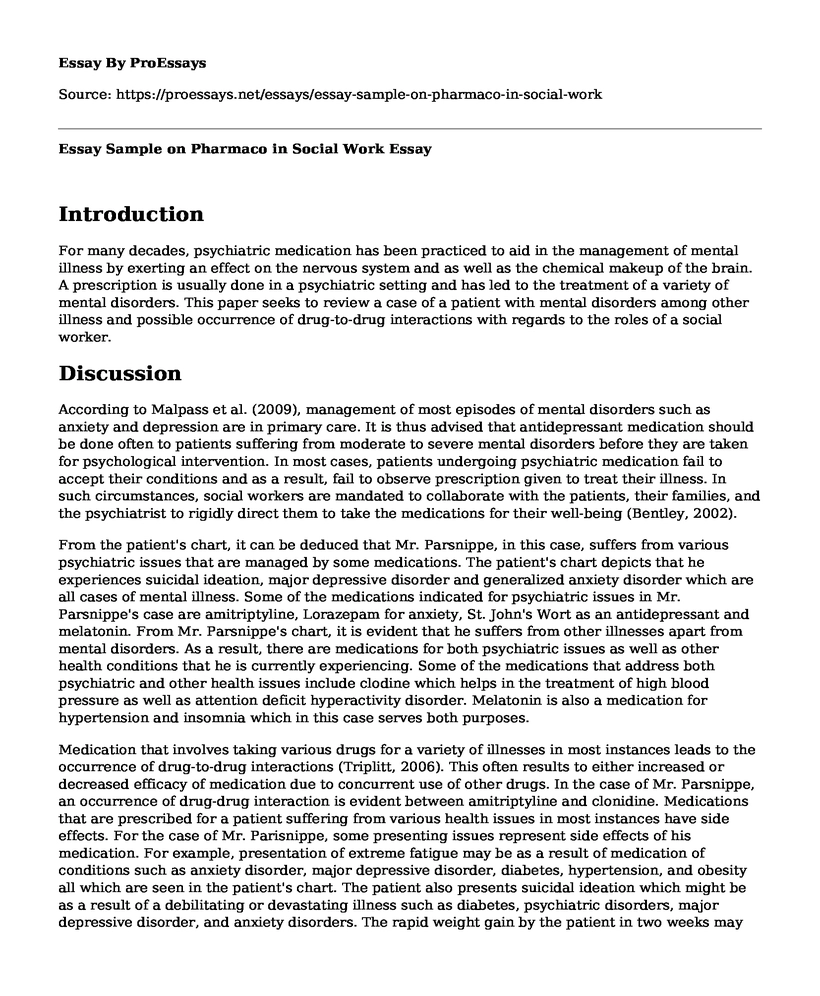Introduction
For many decades, psychiatric medication has been practiced to aid in the management of mental illness by exerting an effect on the nervous system and as well as the chemical makeup of the brain. A prescription is usually done in a psychiatric setting and has led to the treatment of a variety of mental disorders. This paper seeks to review a case of a patient with mental disorders among other illness and possible occurrence of drug-to-drug interactions with regards to the roles of a social worker.
Discussion
According to Malpass et al. (2009), management of most episodes of mental disorders such as anxiety and depression are in primary care. It is thus advised that antidepressant medication should be done often to patients suffering from moderate to severe mental disorders before they are taken for psychological intervention. In most cases, patients undergoing psychiatric medication fail to accept their conditions and as a result, fail to observe prescription given to treat their illness. In such circumstances, social workers are mandated to collaborate with the patients, their families, and the psychiatrist to rigidly direct them to take the medications for their well-being (Bentley, 2002).
From the patient's chart, it can be deduced that Mr. Parsnippe, in this case, suffers from various psychiatric issues that are managed by some medications. The patient's chart depicts that he experiences suicidal ideation, major depressive disorder and generalized anxiety disorder which are all cases of mental illness. Some of the medications indicated for psychiatric issues in Mr. Parsnippe's case are amitriptyline, Lorazepam for anxiety, St. John's Wort as an antidepressant and melatonin. From Mr. Parsnippe's chart, it is evident that he suffers from other illnesses apart from mental disorders. As a result, there are medications for both psychiatric issues as well as other health conditions that he is currently experiencing. Some of the medications that address both psychiatric and other health issues include clodine which helps in the treatment of high blood pressure as well as attention deficit hyperactivity disorder. Melatonin is also a medication for hypertension and insomnia which in this case serves both purposes.
Medication that involves taking various drugs for a variety of illnesses in most instances leads to the occurrence of drug-to-drug interactions (Triplitt, 2006). This often results to either increased or decreased efficacy of medication due to concurrent use of other drugs. In the case of Mr. Parsnippe, an occurrence of drug-drug interaction is evident between amitriptyline and clonidine. Medications that are prescribed for a patient suffering from various health issues in most instances have side effects. For the case of Mr. Parisnippe, some presenting issues represent side effects of his medication. For example, presentation of extreme fatigue may be as a result of medication of conditions such as anxiety disorder, major depressive disorder, diabetes, hypertension, and obesity all which are seen in the patient's chart. The patient also presents suicidal ideation which might be as a result of a debilitating or devastating illness such as diabetes, psychiatric disorders, major depressive disorder, and anxiety disorders. The rapid weight gain by the patient in two weeks may be as a result of medications, lack of sleep and stress.
According to Bentley (2002), some of the roles played by a social worker about medication of a patient include facilitation of a collaborative working relationship between the patient, psychiatrist and family members to ensure successful management of their conditions. In the case of Mr. Parisnippe, as a social worker would empower him to use his ways of looking at the world so that he can understand the meaning of psychotropic medication. The social worker would also help in monitoring the side effects resulting from medicines given to him. Self-management of the client can also be facilitated by the social worker. A social worker, in this case, can recommend drugs to be prescribed by the physician, constant checking of the patient's state, persuade the patient to follow prescribed drug regimen, assist him in stopping taking drugs where necessary and make him understand the drug effects (Cohen, 2004).
References
Bentley, K. J. (Ed.). (2002). Social work practice in mental health: Contemporary roles, tasks, and techniques. Brooks/Cole Publishing Company.
Cohen, D. (2004). The psychiatric medication history: Context, purpose, and method. Social Work in Mental Health, 1(4), 5-28.
Malpass, A., Shaw, A., Sharp, D., Walter, F., Feder, G., Ridd, M., & Kessler, D. (2009). "Medication career" or "moral career"? The two sides of managing antidepressants: a meta-ethnography of patients' experience of antidepressants. Social science & medicine, 68(1), 154-168.
Triplitt, C. (2006). Drug interactions of medications commonly used in diabetes. Diabetes Spectrum, 19(4), 202-211.
Cite this page
Essay Sample on Pharmaco in Social Work. (2022, Dec 18). Retrieved from https://proessays.net/essays/essay-sample-on-pharmaco-in-social-work
If you are the original author of this essay and no longer wish to have it published on the ProEssays website, please click below to request its removal:
- The Kaplan-Meier Method
- Cancer Among Asian Americans Essay
- Supplements for Strength-Power Athletes Paper Example
- Epiville Control Case Study
- Was Ruth Sparrow Wrong to Try to Sell Her Kidney? - Essay Sample
- Research Paper on Growth & Development: How Childhood Nutrition Shapes Life as an Adult
- COVID-19: Impact on Our High School Closure & Education - Essay Sample







